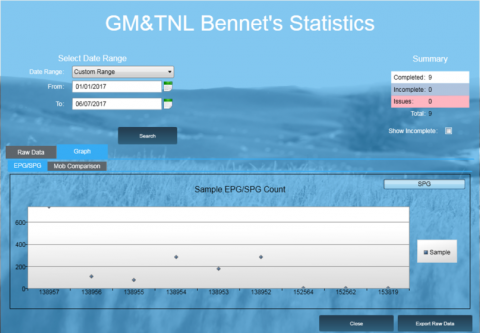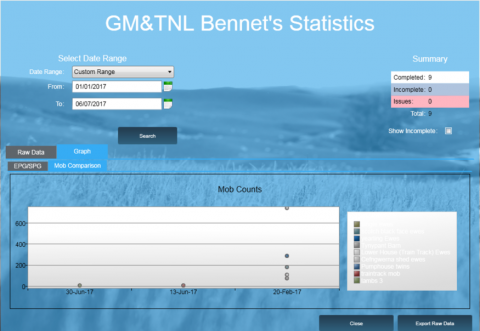The three main areas to address at Tyn Y Pant were;
- Roundworm burden in lambs and first grazing season ewe lambs and yearlings.
- Fluke control.
- Thin ewes at lambing.
1. Roundworm burden
Faecal Worm Egg counts (FECs) have been used extensively at Tyn Y Pant for the past 18 months. Since October 2016, we have carried out 42 FECs on the FECPAK G2 system. Most of these samples were monitoring late season lambs and ewes/yearlings throughout the Autumn and Winter.
Batches of ewes were tested in the Autumn. Of the groups sampled, none had a high enough worm burden to warrant an Autumn dose of wormer. Having this knowledge to hand saved both time and money for the farmer. The financial saving here, in very simple terms would equate to around £285 (1000 ewes drenched + one 8-hour day of work for 2 farm workers @£10 an hour). The benefits in terms of avoiding selection pressure for resistance are invaluable.
Ewes were monitored pre-lambing to allow for treatment to be administered at the most appropriate time (coinciding with the peri-parturient rise). Most groups did not require a dose of anthelmintic until housing. By monitoring worm burden, unnecessary handling of the ewes prior to housing was avoided thus minimising the risk of stress induced abortion.
In addition to monitoring FECs, an anthelmintic resistance profile was carried out. It revealed that there is resistance to Yellow drenches at Tyn Y Pant. White, Clear and Moxidectin anthelmintic drugs appear to be effective. This is invaluable information for the farm as they can now select wormers that are known to be effective. Regular drench checks will be conducted to continue to monitor the drenches. Using effective treatments will help maximise lamb growth and improve profit margin.
The Bennet’s have found FECs to be a useful tool in helping them decide when to drench and when to avoid unnecessary treatment. In general, due to better targeted treatments and grazing management, the FECs have been relatively low, which is a great sign that the measures we have implemented are working.
2. Fluke
Fluke burden in the ewes at Tyn Y Pant was investigated. Eight weeks following treatment with a Triclabendazole drench in the Autumn, faecal samples were tested. Fluke eggs were detected in one of the five groups sampled indicating that there was active infection in this group. Resistance to Triclabendazole was suspected. A resistance profile was initiated (including sampling, weighing and drenching individual ewes), however results of Fluke Coproantigen testing of individual ewes showed low fluke burden at the time, so resistance could not be evaluated. Further investigation will be required and will be carried out when fluke burden is high.
Our results show that only a small proportion of ewes were positive for fluke at the time of year, reflecting the positive steps we have taken to control fluke at Tyn Y Pant. It may suggest that not all ewes will require a second Autumn fluke treatment, however currently, we cannot accurately identify which ewes are most in need of treatment and further work will be carried out to determine the best treatment and control policy at Tyn Y Pant.
3. Thin ewes
We have introduced Body Condition Scoring (BCS) at Tyn Y Pant. All ewes were scored at scanning. Ewes were then grouped according to scanning results and BCS as opposed to scanning result alone. Thin twins (<CS2) were put with triples, thin singles were put with twins etc. By grouping ewes in this manner, feed (and therefore money) could be directed to the groups which would benefit the most i.e. the single bearing ewes in good body condition, needing less energy, were left outdoors for longer and fed less concentrates than usual, and the thinner ewes carrying multiple lambs were on a higher plane of nutrition to meet their demands during pregnancy.
Because of dietary management and careful planning, thinner ewes could restore body condition in time for lambing. Consequently, lambs were born stronger and milk production by the ewes was improved both in quantity and quality.
Condition will be monitored at weaning and ewes grouped accordingly. Thin ewes will be nurtured over the summer months and tests carried out to monitor fluke and worm burden as described above. Any ewes that are still in sub optimal condition at tupping will be culled. By ensuring ewes are meeting BCS targets, benefits will become apparent in the scanning percentages and in their ability to produce high quality lambs and support their development throughout pregnancy and lactation.
There is no doubt that by addressing the issues discussed in this report, production efficiency and profit margins have been and will continue to improve at Tyn Y Pant.


